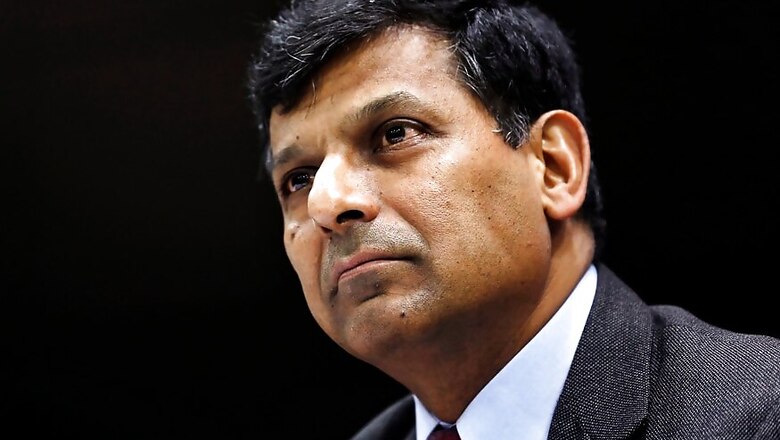
views
New Delhi: Former Reserve Bank of India governor Raghuram Rajan on Tuesday that there was plenty of blame to go around for the nearly Rs 13,500 Punjab National Bank scam.
Rajan, who was RBI governor from 2013 to 2016, broke his silence on the scam after allegations were levelled against the 80:20 gold scheme rolled out in 2014.
This comes after a letter by the India Bullion and Jewellers Association (IBJA) written to Rajan on July 26, 2014, surfaced in which it accused the previous UPA government of “deliberately yielding to the cronies” by changing the gold policy days before demitting office.
“Any policy has ramifications, both positive and negative. There is plenty of blame to go around for the PNB fraud. Need to look into how the PNB scam occurred, where the lapses happened,” Rajan told CNBC-TV18.
“We also need to ask questions who appoint these board members of PNB (who allowed the scam to take place). We need to think very seriously on public sector bank governance reforms,” he added.
He also said that had the RBI had any idea of what was going on at the time, it would have done everything in its power to stop it. “This (PNB scam) was something off the books,” he said.
As for the 80:20 gold scheme, Rajan said that that the scheme was brought in to combat the lack of gold supply and bring back jobs in the Indian jewellery sector. Rajan said the government in 2014 was looking to relax import restrictions on gold after the rupee after a rough 2013. The central bank then implemented the 80:20 scheme to allow importers of gold to start importing again but with certain conditions in place.
In its letter, IBJA said that the RBI circular on May 21, 2014 had “sidestepped nationalised banks, which have been the backbone support of our bullion importing and jewellery exporting members by allowing certain private sector export houses to import gold up to two tonnes at one time, even for those who are not in the business of bullion and gold jewellery”.
Rajan also hit out at social media after a fake quote was attributed to him, which claimed that he had warned Congress President Rahul Gandhi and former finance minister P Chidambaram about Nirav Modi, and about financial irregularities at Punjab National Bank, during his tenure. “Social media has a habit of attributing complete rubbish to me,” he said.
Below is the full transcript of the interview.
Q: First for starters, we have to start with the frauds because that is the reason why we are asking this question who’ fault is it? Is it the fault of the owner of the bank, the auditor, the regulator or the management?
A: There is plenty of blame to go around, but it is important to first focus on why the fraud occurred and what systems were inadequate. In any such thing and I am sure the investigation will go into all these details, but why was this Letter of Undertaking (LoU) given. Why was it not recorded in the banking system? Did management take notice of it? Was it put before the board? And of course after that did the auditors pick it up, if they didn’t why didn’t they pick it up because auditors go branch by branch and then were the regulators instructions obeyed over time or were they not and why were they not obeyed? Of course the owner in this case the government which appoints the board members as well as the management what is their culpability in this whole thing. I think every facet has to be examined.
One of the important concerns about frauds that I had when I was at the Reserve Bank of India (RBI) was that we unearth them, but we never actually brought any of the culprits to book. So, one of the things we did was we said we need to bring together all the people involved both in unearthing as well as investigating and see how we can move forward. So, we sent a list of the big frauds to the Prime Minister’s Office to try and get some action on that. So, these are the kinds of things we need to figure out.
Q: When you were governor, many of these LoU’s were signed and used to get letters of credit and actually a letter when you were governor on August 03rd 2016 was sent to all the banks asking them to thoroughly scrutinise the SWIFT system, audit it. Looks like you all were sensitive that a problem can come from this SWIFT connectivity to the core banking system. Can the supervisor be blamed for not pushing hard enough to get their instruction implemented?
A: Before we assign blame, we have to know what happened and why it happened. In many banking systems there are so many ways of getting around the system. We have to understand that when a way is discovered for example with the SWIFT system it was the problem at Bangladesh Bank which unearthed the problems that were there. When the problem is discovered it is important that the regulators send the message to the banks that we have unearthed this problem, now fix it in your systems.
Of course after that the regulator basically assumes to some extent that the banks have fixed it. If they haven’t, we have to understand why the banks didn’t. I mean when they were told about a problem why wasn’t the problem fixed and I understand they were other reminders sent after that by the Reserve Bank and we have to understand why they weren’t obeyed. So, there is a fair amount of learning from this episode that we need to get. But surely there is plenty of responsibility to spread around.
Q: Hot from the oven news is that the Reserve Bank has banned LoUs. News coming in just about 10 minutes back. Way to go you think?
A: I can’t opine on current policy and I am sure they have looked at the issues. One of my concerns in India is that there is sometimes a very ---cavalier treatment of guarantees whether it is bank given guarantees or government given guarantees. We don’t think these are real and it is only when they are called upon by the entity that has relied on them that we understand that it is almost like giving a loan or in fact more than giving a loan because it usually called upon when the loan is in distressed. So, it is actually like providing equity. Unless we account for these properly there are huge contingent liabilities on the government balance sheet as well as on the bank balance sheet and it is important that we acknowledge them.
Q: You are speaking about pushing blame around and the government has picked up this 80:20 gold scheme as one of the ways in which people were allowed to make money. What are your comments on – you must have heard what the government said about this?
A: As far as I understand, the Punjab National Bank (PNB) scam started in 2011 and was unearthed in 2018. The gold scheme that is under the scanner at this point was something which lasted between May 2014 and November 2014. It seems to me very hard to argue that whatever happened then and I am happy to talk more about that, but whatever happened there was in any way related to the scam other than it happened in the same industry that there was gold involved. It is important to treat these has two separate issues. Happy to talk about the 80:20 because the actions there as far as I understand were justified, but I think it is important to keep it separate from the scam.
A people conflate this all the time and I think this seems to be diversion of public interest rather than a focus on the key issues which are important. Why is it that our banking system is leaking so much? How do we prevent the leaks especially when there is so much new money going into the banking system as re-capitalisation?




















Comments
0 comment